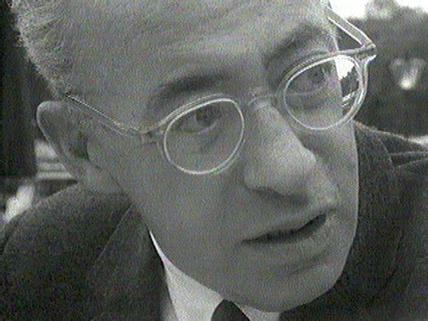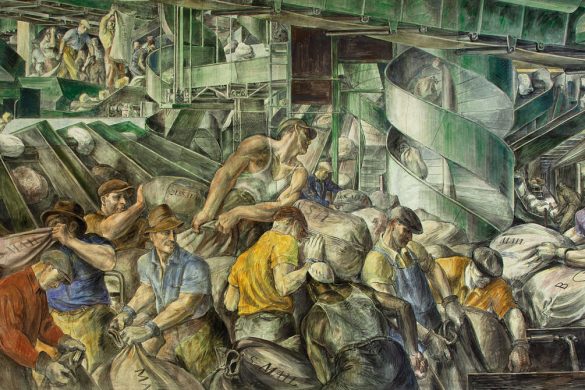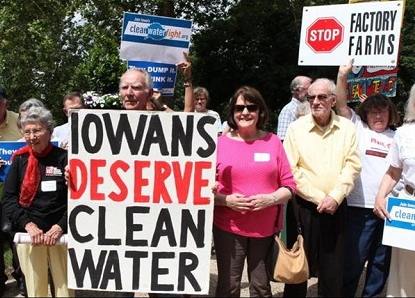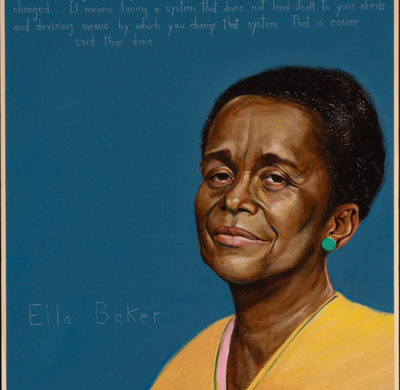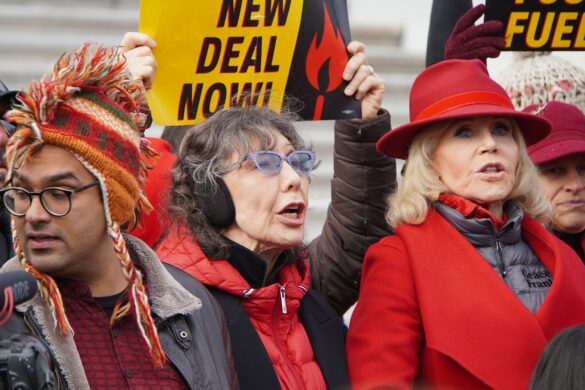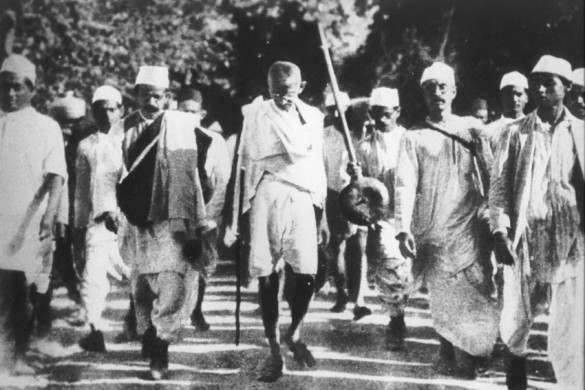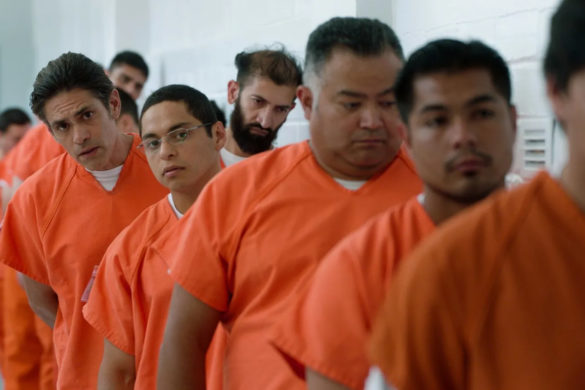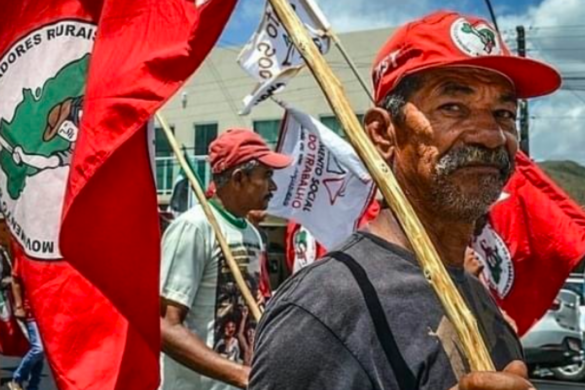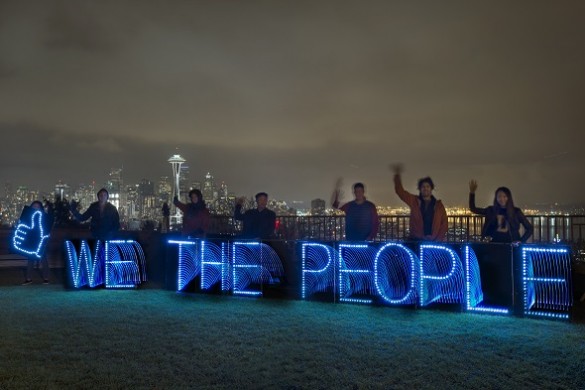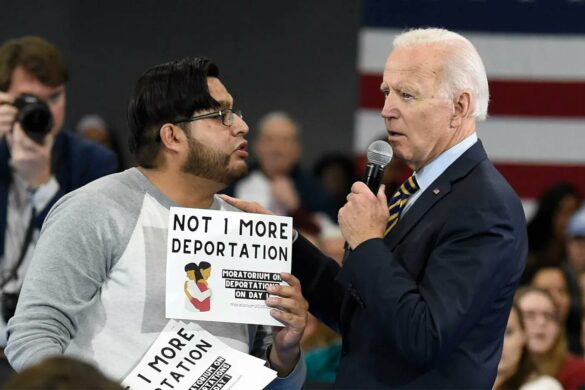By Mark Engler and Paul Engler
(Published on April 2, 2014 in Waging Nonviolence. Photo Credit: Wikipedia/Waging Nonviolence)
Although Saul Alinsky, the founding father of modern community organizing in the United States, passed away in 1972, he is still invoked by the right as a dangerous harbinger of looming insurrection. And although his landmark book, Rules for Radicals, is now nearly 45 years old, the principles that emerged from Alinsky’s work have influenced every generation of community organizers that has come since.
The most lasting of Alinsky’s prescriptions are not his well-known tactical guidelines — “ridicule is man’s most potent weapon” or “power is not only what you have, but what the enemy thinks you have.” Rather, they are embedded in a set of organizational practices and predispositions, a defined approach to building power at the level of local communities. Hang around social movements for a while and you will no doubt be exposed to the laws of Chicago-style community organizing: “Don’t talk ideology, just issues. No electoral politics. Build organizations, not movements… Focus on neighborhoods and on concrete, winnable goals.”
Veteran labor writer David Moberg recently offered this list when reflecting on the work of National People’s Action, or NPA, one of today’s leading coalitions of community-based groups. Given that NPA’s dynamic executive director, George Goehl, was trained by Shel Trapp — a prominent Alinsky disciple — it is no surprise that traditional community organizing principles are still reflected in the bottom-up, door-to-door methodologies of NPA affiliates in 14 states.
At the same time, under Goehl’s leadership, National People’s Action is also doing many things differently. His coalition is now embracing a big-picture vision (talking about cooperative ownership of business and public control of finance), and it is making forays into electoral politics (forming a lobbying arm to do legislative advocacy and possibly even to run candidates). In pushing beyond Alinsky’s traditional rules, Goehl is motivated not only to win concrete reforms within the existing political system but to develop, Moberg writes, the “vision, strategy, and full arsenal of political weapons needed to roll back decades of corporate conservative victories and to create a more democratic economy and government.”
Goehl’s ambition is not unique. Other community organizers who experienced the Occupy movement were impressed by the massive momentum for change it created — even if much of its force proved fleeting. Efforts such as the 99% Spring and Occupy Our Homes were steps by community-based groups toward integrating their traditional organizing models with the social movement energy that had blossomed in Zuccotti Park and beyond.
The desire to re-examine maxims such as “build organizations, not movements” is an exciting developing — one that opens the door to interaction between those focused on building long-term “people’s organizations,” as Alinsky called them, and those exploring the dynamics of strategic nonviolence and disruptive mass mobilization.
It is also one that Alinsky himself may well have supported.
Looking back at the origins of many foundational principles associated with the Alinskyite organizing tradition, it becomes clear that some were not as deeply rooted in the founder’s thinking as others — and that he might have pressed for reconsideration of certain commandments that have grown hallowed since the 1960s. These discrepancies raise an intriguing question: If Alinsky were alive today, would he be breaking his own rules?
* * *
In recent years, Saul Alinsky has become known for of his connections to prominent figures inside Washington, D.C. In the 1980s, Barack Obama cut his political teeth as an organizer in an Alinskyite community organization, an initiative on the South Side of Chicago known as the Developing Communities Project. Hillary Clinton’s undergraduate thesis at Wellesley College was entitled, “There is Only the Fight: An Analysis of the Alinsky Model.” Because of these links, Glenn Beck featured Alinsky prominently on his maps of leftist conspiracy in America, and Newt Gingrich regularly used the organizer as a foil on the campaign trail in 2012.
There is some irony to these beltway associations, given that Alinsky built his reputation as an anti-establishment radical working squarely outside the domain of electoral politics. A Chicago native and son of Russian-Jewish immigrants, Alinsky got his start organizing in the 1930s, inspired by CIO and United Mine Workers leader John L. Lewis. In spite of mentoring from Lewis, Alinsky was convinced that the labor movement had grown lethargic and that American democracy needed “people’s organizations” based outside the workplace — citizens’ groups with roots in local communities.
In his first attempt to create such a group he founded the Back-of-the-Yards Neighborhood Council, an effort to organize the ethnically diverse workers who lived behind the meatpacking plants featured in Upton Sinclair’s muckraking 1906 novel, The Jungle. To fight the slum conditions facing this community, Alinsky packed the offices of bureaucrats with hundreds of residents and routed marches past the homes of local officials. “Many confrontations and several months later,” author Mary Beth Rogers writes, “Back of the Yards claimed credit for new police patrols, street repairs, regular garbage collection, and lunch programs for 1,400 children.”
By 1940, with the help of funding from wealthy liberal Marshall Field III, Alinsky had created a nonprofit known as the Industrial Areas Foundation, or IAF, tasked with spurring organization in other urban neighborhoods. In the 1950s, Alinsky and Fred Ross worked through the IAF-supported Community Service Organization to improve living conditions for Mexican-Americans in California; there, Ross recruited a young organizer in San Jose named Cesar Chavez and another in Fresno named Dolores Huerta. (Only after years of training did Chavez and Huerta leave to form what would become the United Farm Workers.)
Among Alinsky’s other prominent campaigns, he would work in the 1960s with black residents in Chicago’s Woodlawn neighborhood to fight exploitative landlords and to challenge school overcrowding, and he would help community members in Rochester, N.Y., compel the Eastman Kodak Company to create a hiring program for African-American workers.
Alinsky taught through stories, usually exaggerated, always entertaining. In 1971 writer Nat Hentoff stated, “At 62, Saul is the youngest man I’ve met in years.” Playboy interviewer Eric Norden agreed. “There is a tremendous vitality about Alinsky, a raw, combative ebullience, and a consuming curiosity about everything and everyone around him,” Norden wrote. “Add to this a mordant wit, a monumental ego coupled with an ability to laugh at himself and the world in general, and you begin to get the measure of the man.”
Alinsky’s first book, Reveille for Radicals became a bestseller when published in 1946; it blasted liberal-minded charity efforts and called for an indigenous American radicalism based in citizen action. Rules for Radicals: A Pragmatic Primer for Realistic Radicals came in 1971, near the end of Alinsky’s life, and remains popular. It was recently circulated by Republican Dick Armey’s organization FreedomWorks to Tea Party members curious about the book’s methods, even if they are opposed to its goals. Its first chapter begins: “What follows is for those who want to change the world from what it is to what they believe it should be. The Prince was written by Machiavelli for the Haves on how to hold power. Rules for Radicals is written for the Have-Nots on how to take it away.”
Frank Bardacke, author of a sweeping history of the United Farm Workers, recounts how Alinsky’s principles for building power solidified into an identifiable organizing tradition: “With Saul as the fountainhead, community organizing has become a codified discipline, with core theoretical propositions, recognized heresies, disciples, fallen neophytes, and splits.” He quotes Heather Booth, founder of the Midwest Academy, an Alinskyite training center for organizers, who calls Alinsky “our Sigmund Freud.”
“What Booth means is that both Freud and Alinsky founded schools of thought,” Bardacke explains, “but there is another, deeper link: the role of training and lineage. Just as psychoanalysts trace their pedigree back to the grand master (they were either analyzed by Freud or by someone who was analyzed by Freud, or by someone who was analyzed by someone who…), so Alinskyite and neo-Alinskyite organizers trace their training back to Alinsky himself.”
Alinsky’s influence today is felt not just in the IAF or Goehl’s NPA — whose member groups range from Community Voices Heard in New York, to POWER in Los Angeles, to Iowa Citizens for Community Improvement. It is also present in networks such as PICO, DART, USAction/Citizen Action, the Gamaliel Foundation, and the former branches of ACORN. Collectively these organizations claim several million members, and the tradition has spread internationally as well, with organizing trainings taking place in Europe, South Africa and the Philippines. Each of the networks, writes sociologist David Walls, is “indebted, in greater or lesser degree, to Alinsky and his early organizing programs in Chicago through IAF.”
* * *
The principle of “no electoral politics” took hold in the Alinskyite tradition based on the idea that community organizations should be pragmatic, nonpartisan, and ideologically diverse — that they should put pressure on all politicians, not express loyalty to any. Historian Thomas Sugrue writes that Alinsky “never had much patience for elected officials: Change would not come from top-down leadership, but rather from pressure from below. In his view, politicians took the path of least resistance.” Alinsky himself was not anti-state — as sociologist P. David Finks writes, for him “the problem was not so much getting government off our backs as getting it off its rear end” — but the focus of his efforts was outside the electoral arena. The IAF’s lingering pride in its “independent, nonpartisan” status reflects its desire to recruit members from across the political spectrum in any given community, not merely to engage the usual suspects of progressive activism.
This “nonpartisan” avoidance of ideology also relates to perhaps the most interesting precept in the Alinskyite tradition: the one which distances community organizing from mass mobilizations. As Rutgers sociology professor and former ACORN organizer Arlene Stein wrote in 1986, “community organizers today tend generally to shun the term movement, preferring to see themselves engaged in building organization.”
Why would someone promoting social change see themselves as wary of movements? There are several reasons, and the way in which the terms “movement” and “organization” are understood connect to some defining aspects of the Alinskyite model.
Ed Chambers, Alinsky’s successor as IAF director, expresses an aversion to movements as a part of his long-term commitment to community members. As he writes in his book Roots for Radicals, “We play to win. That’s one of the distinctive features of the IAF: We don’t lead everyday, ordinary people into public failures, and we’re not building movements. Movements go in and out of existence. As good as they are, you can’t sustain them. Everyday people need incremental success over months and sometimes years.”
Alinsky, too, saw a danger in expecting quick upheavals. He argued, “Effective organization is thwarted by the desire for instant and dramatic change…. To build a powerful organization takes time. It is tedious, but that’s the way the game is played — if you want to play and not just yell, ‘Kill the umpire.'” Before entering a neighborhood, Alinsky planned for a sustained commitment. He would not hire an organizer unless he had raised enough money to pay for two or more years of the staffer’s salary.
Beyond setting expectations for timeframe, a dedication to “organizations not movements” is reflected in several other Alinskyite norms. These include the tradition’s connection to churches and other established institutions, its selection of bottom-up demands rather than high-profile national issues, and its attitude toward volunteers and freelance activists.
Alinsky believed in identifying local centers of power — particularly churches — and using them as bases for community groups. The modern IAF continues to follow this principle, serving as a model of “faith-based” organizing.
Instead of picking a galvanizing, morally loaded, and possibly divisive national issue to organize around — as would a mass movement — Alinsky advocated action around narrow local demands. Mark Warren’s Dry Bones Rattling, a study of the IAF, explains: “As opposed to mobilizing around a set or predetermined issues, the IAF brings residents together first to discuss the needs of their community and to find a common ground for action.” Practicing what is sometimes called “stop sign organizing,” those working in this vein look for concrete, winnable projects — such as demanding that city officials place a stop sign at a dangerous intersection. The idea is that small victories build local capabilities, give participants a sense of their power, and spur more ambitious action.
They also meet some of the immediate needs of the community — far preferable, in Alinsky’s view, to social movements’ far-off calls for freedom and justice. Throughout his career, Alinsky spoke the language of self-interest. He looked to build democratic power among community members seeking to improve the conditions of their own lives. He was suspicious of volunteer activists who were motivated by abstract values or ideology, people drawn to high-profile moral crusades. That movements were full of such people did not sit well with the Alinskyites. As Chambers writes: “Activists and movement types are mobilizers and entertainers, not democratic organizers. Their script is their persona and their cause. They tend to be overinterested in themselves. Their understanding of politicalness is superficial or media-driven. They lack disinterestedness.”
Moreover, Chambers contends, movement activists’ expectations for change are far too short-term: “Their time frame is immediate. ‘What do we want?’ ‘Freedom.’ ‘When do we want it?’ ‘Now!’ ‘No justice, no peace,'” he explains dismissively. “Movement activists appeal to youth, frustrated idealists, and cynical ideologues, ignoring the 80 percent of moderates who comprise the world as it is…. Organizing is generational, not here today, gone tomorrow.”
Chambers’s view may seem harsh, but it is not atypical of those drawn to community organizing. As Stein explains, “[T]he revival of Alinsky-style organizations in the 1970s and 1980s often defined itself against the social movements of the previous decade — especially the civil rights, women’s, and student antiwar movements — which it tended to view as promoting collective identity formation over the achievement of strategic goals.”
Patient base-building, long-term strategy, incremental local wins. These ingredients would contribute to a lasting and influential organizing model. They would also, in the turbulent 1960s, put Alinsky at the center of an activist culture clash.
* * *
At the same time that Alinsky became a popular speaker on 1960s campuses, his vision of organizing put him at odds with many of the era’s leading activists — both its student militants and its more high-profile leaders, such as Martin Luther King, Jr. In 1965 and 1966, tensions between “organization” and “movement” surfaced when King and his Southern Christian Leadership Council came to Chicago, Alinsky’s home turf, to mount their first Northern civil rights drive.
During the campaign, Nicholas von Hoffman, a close Alinsky lieutenant, had a chance encounter with King in Memphis, Tenn., in the hospital where activist James Meredith had been taken after being shot while marching in support of black voter registration. Von Hoffman gave King his advice about Chicago: “I told him I thought it could succeed if he was prepared for trench warfare, which would demand tight, tough organization to take on the Daley operation,” von Hoffman writes. “I added it could not be done in less than two years.”
Von Hoffman was not convinced that King was listening. He knew that the SCLC — coming off of mobilizations in Birmingham and Selma — had grown accustomed to much shorter campaigns, sometimes lasting just months. Nor was he impressed by King’s decision to move his family into an apartment in one of Chicago’s poorest neighborhoods, which von Hoffman dismissed as a “dramatic gesture” of little utility. “Organizing is akin to stringing beads to make a necklace,” von Hoffman argued. “It demands patience, persistence, and some kind of design. King’s campaign in Chicago was short on beads and bereft of design.”
Alinsky and von Hoffman regarded the SCLC leader as a “one-trick pony” who relied too heavily on media-seeking marches, and they held his team in low regard. As von Hoffman contended, King and the outsiders he brought into Chicago “were, as far as I could tell, a hodgepodge of young white idealists, college kids, and summer soldiers, most of whom had no knowledge of the people they were supposed to recruit. In the South the youthful white idealists were useful civil rights cannon fodder; in Chicago they were dead weight.”
Von Hoffman noted the contrast with his tradition: “It was the antithesis of an Alinsky operation where outside volunteers were generally shooed away not only because they got in the way but also because they didn’t have any skin in the game,” he wrote. “Laudable as it is to volunteer to help other people wrestle with their problems, effective organizations are built with people who have direct and personal interest in their success.”
This type of analysis reflected Alinsky’s broader critique of civil rights organizing. In a 1965 interview he argued, “The Achilles’ Heel of the civil rights movement is the fact that it has not developed into a stable, disciplined, mass-based power organization.” He believed the movement’s victories owed much to uncontrollable world-historical forces, to “the incredibly stupid blunders of the status quo in the South and elsewhere,” and to the contributions of church institutions.
He added, with King as his unnamed subject: “Periodic mass euphoria around a charismatic leader is not an organization. It’s just the initial stage of agitation.”
For Alinsky, stressing the importance of strong organization was also a matter of bridging a generation gap. Those yelling “kill the umpire,” in his view, were the members of the New Left. Alinsky felt that people his age were partially responsible for the youths’ ignorance. In writing Rules for Radicals, he sought to communicate with 1960s activists whom he saw as suffering from a lack of mentoring — the result of a missing generation of organizers. “Few of us survived the Joe McCarthy holocaust of the 1950s,” Alinsky wrote, “and of those there were even fewer whose understanding and insights had developed beyond the dialectical materialism of orthodox Marxism. My fellow radicals who were supposed to pass on the torch of experience and insights to a new generation just were not there.”
As a consequence, young leftists were too easily seduced by quick fixes, Alinsky believed. In an afterward to a 1969 reissue of his first book, Reveille for Radicals, he wrote, “The approach of so much of the present generation is so fractured with ‘confrontations’ and crises as ends in themselves that their activities are not actions but a discharge of energy which, like a fireworks spectacle, briefly lights up the skies and then vanishes into the void.”
The creation of an alternative methodology — what Stein describes as “a highly structured organizing model specifying step-by-step guidelines for creating neighborhood organizations” — was an understandable response, and one that has shown great strengths. But, in recent decades, we may have seen its limitations as well.
The question is whether too close an adherence to a hardened model has created missed opportunities — chances to integrate structure-based organization and momentum-driven movements, and to harness the power of both.
* * *
It turns out that many of the rules of the Alinskyite tradition come less from the founder himself and more from his successors’ subsequent codification of his ideas.
After Alinsky’s death, IAF leaders Ed Chambers, Richard Harmon, and Ernesto Cortes sat down to assess the factors that contributed to the failure of earlier organizing drives. As author Mary Beth Rogers writes, they identified several “patterns that created instability, ineffectiveness, and eventual dissolution.” Among them: “Movements that depended on charismatic leaders fell apart in the absence of the leader;” “organizations formed around a single issue died when the issue lost its potency;” and “organizations that played to the public spotlight confused their desire for media attention with their strategy for change.”
Clearly, the IAF heavyweights were critical of the social movements of the New Left. But, more surprisingly, their assessment also indicted Alinsky’s own work.
While the founding father had planted seeds for organizations throughout the country, only a handful survived for longer than three years. As IAF organizer Michael Gecan writes in his book Going Public, “Alinsky was extraordinarily effective as a tactician, writer, speaker and gadfly. He was the first theorist and exponent of citizen organizing in urban communities.” But, “While Alinsky had many gifts and strengths… he did not create organizations that endured.”
This challenge would be left to his successors, in particular Ed Chambers. “That was Chambers’s critical contribution to the world of citizens organizing and to America as a whole,” Gecan writes. “He had a talent for teaching people how to organize power that lasted.” Chambers’ systemization of the Alinsky model would involve formalizing processes for recruiting and grooming organizers, relying less on large foundations for funding, improving working conditions to reduce burn-out, and strengthening ties to faith-based groups. Other networks of community organizations would further the model by bringing local groups into national coalitions and creating their own training programs to refine and spread the rules of grassroots power-building.
In many respects, these were necessary changes. Yet they may have come at the cost of some of Alinsky’s original creativity. In their focus on building for the long term and creating strong organizational structures, subsequent community organizing leaders have grown less sensitive than their tradition’s founder to the potential of exceptional moments of mass mobilization.
In truth, Alinsky was far less rigid than the “rules” attributed to him might suggest. Nicholas von Hoffman, in a memoir about his time with Alinsky, describes his former mentor as “one of the least dogmatic and most flexible of men. Alinsky believed that liberty was to be redefined and rewon by every generation according to its circumstances and the demands of the time.” For his part, Alinsky liked to tell a story, possibly apocryphal, of sitting in on a university exam designed for students of community organization. “Three of the questions were on the philosophy and motivations of Saul Alinsky,” he claimed. “I answered two of them incorrectly!”
This flexibility affected his view of elections. Alinsky’s biographer, Sanford Horwitt, notes that the organizer had plans to run a candidate for Congress in a 1966 election on Chicago’s South Side, and he sent staffers from Woodlawn to serve on the campaign of an anti-machine challenger. Horwitt quotes von Hoffman, who says, “A lot of people, especially those who turned ‘community organizing’ into a kind of religion, now take it as gospel from Saul Alinsky… that one never gets directly involved in electoral politics. Well, he never thought that.”
More importantly, Alinsky’s take on mass mobilization was not one-dimensional. One of the most interesting moments in his career came when he attempted to integrate the energy of a social movement with the work of one of his community organizations.
While organizing in the Woodlawn neighborhood in early 1961, von Hoffman got a call from a civil rights activist taking part in the Freedom Rides, a protest designed to challenge segregated interstate bussing in the South. The riders were violently attacked in Alabama — one of their buses was burned in Anniston, and they were beaten by a mob in Montgomery. Having just been released from a New Orleans hospital, the activist and some of his fellow participants contacted von Hoffman to express interest in making their first public appearance in Chicago.
Von Hoffman was initially hesitant — wary that the event would not advance local organizing and mindful of previous civil rights rallies in Chicago that drew only a handful of picketers. Yet he arranged for a talk to be held in a large gymnasium in St. Cyril’s Church. As Horwitt writes, “On a Friday night, two hours before the program was to start, the gym was empty and von Hoffman was nervous — his initial fears seemed about to be confirmed. An hour later, an elderly couple arrived, and then, to von Hoffman’s total amazement, so many people turned up that there was no room left in the gym, in the foyer, or on the stairs.”
Von Hoffman arranged for loudspeakers to broadcast the talk to the hundreds of people in the streets outside the venue. Later, he left the event reeling. Far more people had come than his group could have possibility mobilized through its organizational structures, and the issue had generated a profound energy in the community. He woke up Alinsky with a middle-of-the-night phone call and explained what happened. Von Hoffman said, “I think that we should toss out everything we are doing organizationally and work on the premise that this is the moment of the whirlwind, that we are no longer organizing but guiding a social movement.”
To his surprise, Alinsky responded by saying, “You’re right. Get on it tomorrow.”
The Woodlawn organization subsequently held its own version of the Freedom Rides — a bus caravan to register black voters. The event, Horwitt recounts, produced “the largest single voter-registration ever at City Hall,” startled the city’s power-brokers, generated much greater publicity than Woodlawn’s typical actions, and set the stage for further civil rights activism by the group. In criticizing Martin Luther King several years later, Alinsky was not trying to write off the civil right movement as a whole. A devotee of headline-grabbing direct action, he recognized its accomplishment. And yet he sought to present its leaders with the challenge of institutionalization — a question which King himself grappled with in his later years and which is vital in thinking about how organizing models might be integrated.
* * *
Alinsky understood something important when he embraced “the moment of the whirlwind.” He saw that using mass mobilization to produce spikes in social unrest is a process that follows a different set of rules than conventional organizing. Many of its principles — embracing demands with wide symbolic resonance, channeling energy and participation from a broader public, articulating self-interest in moral and visionary terms — are the opposite of the principles that drive local community organizing. And yet Alinsky was willing to experiment with their possibilities.
Former ACORN organizer Stein argues that such openness became a rarity among Alinsky’s disciples. The Alinskyite organizations of recent decades, she writes, “often fail to grasp the possibilities of mobilization when they occur.” Because of this, they have unduly limited themselves. “The great social movements of American history — labor, populist, civil rights, women’s (to name some of the most important ones),” Stein argues, “captured the interest and imagination of vast numbers of people by offering them material benefits as well as the experience of communal solidarity in an individualistic American culture. In placing ‘organization’ ahead of ‘movement,’ ACORN and groups like it” miss this. They discount modes of organizing that tap the transformative possibility of going beyond the most local, concrete or winnable demands.
Whether it is the global justice protests of 1999 and 2000, the massive immigrant rights marches of 2006, or the rapid spread of Occupy Wall Street across the country in 2011, veteran organizers are often caught off guard by movement outbreaks. As a result, they have few ideas for how to guide and amplify these efforts — or how to harness the energy of peak moments in order to propel their ongoing organizing.
Fortunately, in the wake of Occupy, an increasing number of people are interested in precisely this challenge. Those now seeking ways to combine structure- and momentum-based organizing models have much fertile terrain to explore. This will mean opening dialogue between the worlds of “resource mobilization” and “disruptive power”; and it will involve allowing those immersed in labor and community organizing cultures to compare their methods with the insights into mass mobilization that come out of traditions of strategic nonviolence and civil resistance.
In pursuing this work, they can take inspiration from a master of radical pragmatism. For while the split between organizations and movements is real, the true spirit of Alinsky is in breaking the rule that keeps them divided.

